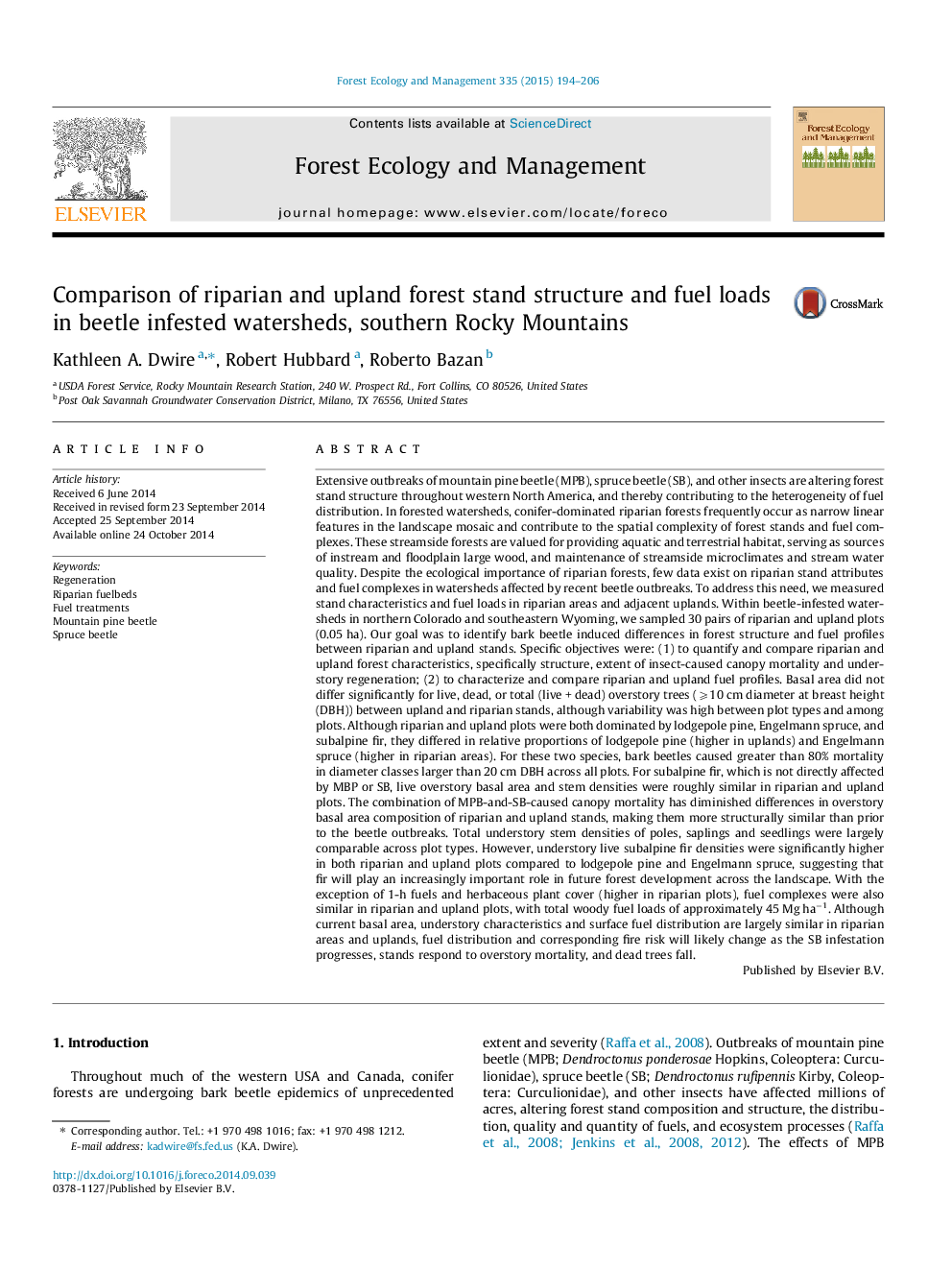| کد مقاله | کد نشریه | سال انتشار | مقاله انگلیسی | نسخه تمام متن |
|---|---|---|---|---|
| 6543019 | 159192 | 2015 | 13 صفحه PDF | دانلود رایگان |
عنوان انگلیسی مقاله ISI
Comparison of riparian and upland forest stand structure and fuel loads in beetle infested watersheds, southern Rocky Mountains
ترجمه فارسی عنوان
مقایسه ساختار ایستگاه جنگل های ساحلی و ارتفاعات و بارهای سوختی در حوضه های آبخیز سوسک، کوه های جنوبی راکی
دانلود مقاله + سفارش ترجمه
دانلود مقاله ISI انگلیسی
رایگان برای ایرانیان
کلمات کلیدی
بازسازی، پمپ بنزین درمان سوخت، سوسک سوسک کوهستان، سوسک یاس
موضوعات مرتبط
علوم زیستی و بیوفناوری
علوم کشاورزی و بیولوژیک
بوم شناسی، تکامل، رفتار و سامانه شناسی
چکیده انگلیسی
Extensive outbreaks of mountain pine beetle (MPB), spruce beetle (SB), and other insects are altering forest stand structure throughout western North America, and thereby contributing to the heterogeneity of fuel distribution. In forested watersheds, conifer-dominated riparian forests frequently occur as narrow linear features in the landscape mosaic and contribute to the spatial complexity of forest stands and fuel complexes. These streamside forests are valued for providing aquatic and terrestrial habitat, serving as sources of instream and floodplain large wood, and maintenance of streamside microclimates and stream water quality. Despite the ecological importance of riparian forests, few data exist on riparian stand attributes and fuel complexes in watersheds affected by recent beetle outbreaks. To address this need, we measured stand characteristics and fuel loads in riparian areas and adjacent uplands. Within beetle-infested watersheds in northern Colorado and southeastern Wyoming, we sampled 30 pairs of riparian and upland plots (0.05 ha). Our goal was to identify bark beetle induced differences in forest structure and fuel profiles between riparian and upland stands. Specific objectives were: (1) to quantify and compare riparian and upland forest characteristics, specifically structure, extent of insect-caused canopy mortality and understory regeneration; (2) to characterize and compare riparian and upland fuel profiles. Basal area did not differ significantly for live, dead, or total (live + dead) overstory trees (⩾10 cm diameter at breast height (DBH)) between upland and riparian stands, although variability was high between plot types and among plots. Although riparian and upland plots were both dominated by lodgepole pine, Engelmann spruce, and subalpine fir, they differed in relative proportions of lodgepole pine (higher in uplands) and Engelmann spruce (higher in riparian areas). For these two species, bark beetles caused greater than 80% mortality in diameter classes larger than 20 cm DBH across all plots. For subalpine fir, which is not directly affected by MBP or SB, live overstory basal area and stem densities were roughly similar in riparian and upland plots. The combination of MPB-and-SB-caused canopy mortality has diminished differences in overstory basal area composition of riparian and upland stands, making them more structurally similar than prior to the beetle outbreaks. Total understory stem densities of poles, saplings and seedlings were largely comparable across plot types. However, understory live subalpine fir densities were significantly higher in both riparian and upland plots compared to lodgepole pine and Engelmann spruce, suggesting that fir will play an increasingly important role in future forest development across the landscape. With the exception of 1-h fuels and herbaceous plant cover (higher in riparian plots), fuel complexes were also similar in riparian and upland plots, with total woody fuel loads of approximately 45 Mg haâ1. Although current basal area, understory characteristics and surface fuel distribution are largely similar in riparian areas and uplands, fuel distribution and corresponding fire risk will likely change as the SB infestation progresses, stands respond to overstory mortality, and dead trees fall.
ناشر
Database: Elsevier - ScienceDirect (ساینس دایرکت)
Journal: Forest Ecology and Management - Volume 335, 1 January 2015, Pages 194-206
Journal: Forest Ecology and Management - Volume 335, 1 January 2015, Pages 194-206
نویسندگان
Kathleen A. Dwire, Robert Hubbard, Roberto Bazan,
